How to Season Cast Iron
Simple instructions for a simple task.
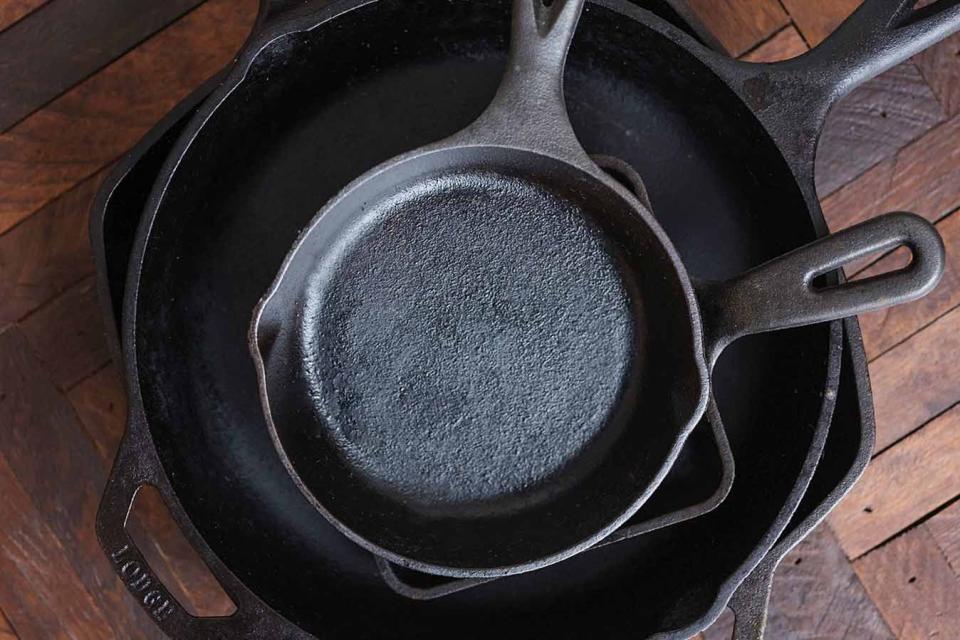
So you found an old skillet at a flea market. Or you put one in the dishwasher. Or you accidentally carbonized a block of tofu. In any case, now the skillet looks like something brought up from Titanic wreckage. Can you save it?
Probably! I resurrected a skillet I'd unearthed from a farmhouse that was over a century old, and it's now the one pan I use more than any other. If I can do it, you can.
And you should be able to pull it off without spending hours researching on the internet. That's where this simple guide comes in. This is a seasoning how-to for people who don't want to do a deep dive.
Before You Start, Figure Out If It's Already Seasoned
Determine if your new-to-you cast iron needs to be seasoned in the first place. Most brand-new cast iron cookware these days comes pre-seasoned (for instance, Lodge and all but the bare finish Stargazer products come pre-seasoned). It'll probably tell you on the packaging. If your cast iron is vintage and in good shape—it's smooth and black—then you probably can just wash it, give it a simple routine maintenance seasoning, and get to cooking.
Read More: This Is How You Should Clean Cast Iron, According to Lodge
Steps for Seasoning a Cast Iron Skillet (Old or New)
This also works with carbon steel, though if it's brand new it probably still has a protective coating, which you should remove first by following the manufacturer's instructions.
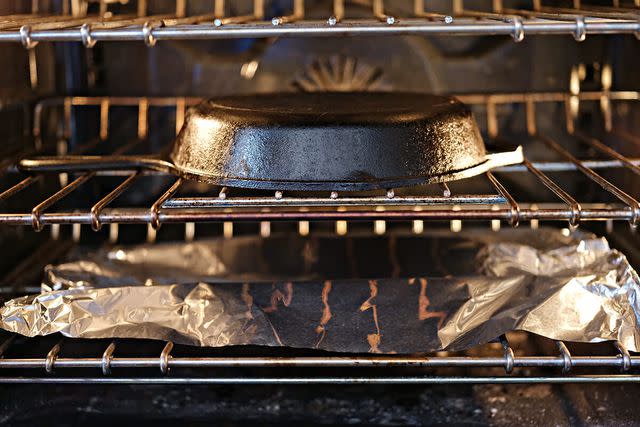
Preheat the oven to 350°F.
Scour the skillet’s rusty spots with dry steel wool or a metal scrubby. (If your skillet is new, it shouldn't have any rust.)
You’ll wind up spreading the loosened rust particles around, and it might not look like you’re making headway. If you wipe away the rusty dust with a paper towel, you’ll see that you are.
Wash the skillet in warm water, scrubbing it with a stiff brush or scouring pad. You can use a little dish soap, if you like, but it’s not necessary.
Dry the skillet. If you see rough, rusty spots repeat steps 2 and 3. If it's still a mess and has caked-on crud, you'll need take a different route, which we detail below.
Give your clean, dry, rust-free skillet a massage all over with neutral cooking oil such as canola or vegetable oil. Use a lint-free rag or paper towel. Don’t be skimpy, but don’t slather it, either—that can give your seasoning a sticky residue.
Put the skillet face-down on a rack in the middle of the oven (face-up might cause oil to pool, leaving a sticky residue). Lay a sheet of foil underneath to catch any drips. Bake the skillet for 1 hour.
Turn off the oven, and let it cool with the skillet in it (put a Post-It on the door so you don’t forget).
Once the cast iron has cooled, examine it. Repeat steps 5 to 6, if needed. If the situation still looks grim, it’s time for drastic measures (see below).
Stripping Cast Iron That's a Total Disaster (It's Possible!)
Very few pieces of cast iron or carbon steel cookware are beyond repair. There are a few approaches to take if a ton of elbow grease hasn't helped old cast iron that refuses to cede its battle scars.
Method 1: Hot Coals
This is good for folks who live out in the country, or at least have decent-sized backyards. Build a robust campfire and let the coals calm down so they're glowing and plentiful. Use a shovel to make a pit, carefully put the cast iron in face down, and then bury it in more hot coals. Just leave it in there overnight until the whole fire dies down. Unearth it the next day. Caution: the embers and cast iron will be too hot to handle with bare hands. One the cast iron is cool, wash it well and go about seasoning it.
Method 2: Self-Cleaning Cycle in Oven
If your oven is self-cleaning, put the cast iron in it face-down right on the rack. Be warned: your house will smell. Let the cycle run and allow the skillet to cool before removing and washing it.
Method 3: Electrolysis
This method looks really cool on TikTok and Instagram, but it's complicated and best for cast iron geeks with a big workshop. In lieu of describing it, I'll just refer you to this post on The Cast Iron Collector.
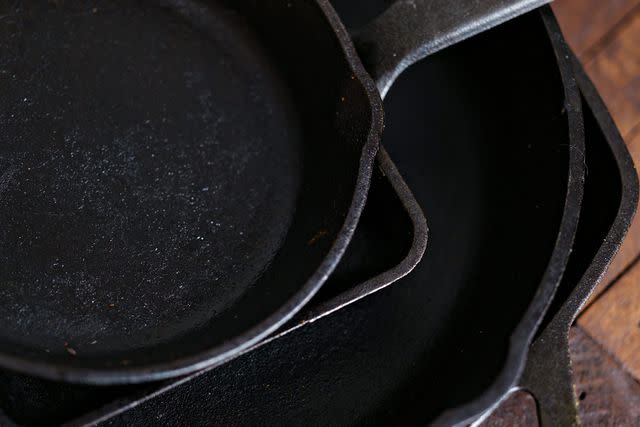
What Is Seasoning, Anyway?
Seasoning is what makes cast iron black. The blacker a skillet, the better it is seasoned.
“Seasoning” refers to a finish, and also to the process of applying that finish. Generally speaking, Oil + Metal + Heat = Seasoning.
When thinly spread over the cast iron and heated for a long period of time, the fatty acids in oil change chemically, oxidizing and creating a slick layer over the surface of the pan. To the naked eye cast iron looks smooth, but it’s got teeny-tiny nooks and crannies where the oil gets trapped and then bonds with the iron.
So, when you season cast iron, you’re making a do-it-yourself, nontoxic nonstick coating. Cool, huh?
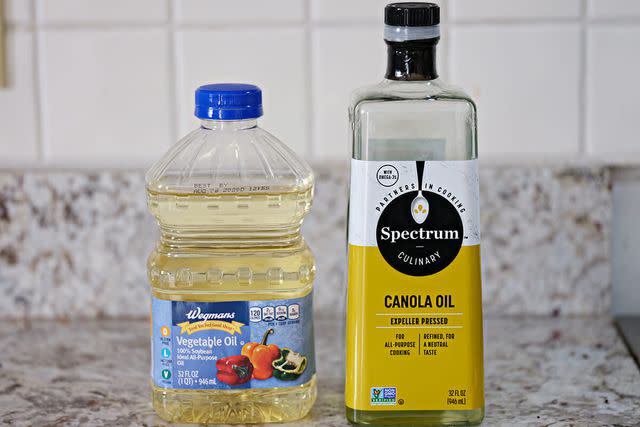
What Oil to Use for Seasoning
In general, you want to use an oil with a high smoke point when you season cast iron, particularly if the cast iron was in bad shape. So-called neutral oils like soybean oil, vegetable oil, and canola oil work fine.
For routine seasoning, I’d say don’t get too hung up on the specific kind of oil; it’s better to season with an oil that’s not the top choice than it is to neglect to care for your skillet.
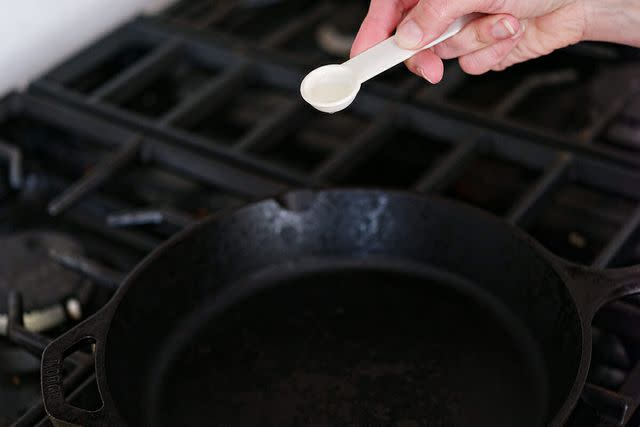
How To Maintain Your Seasoning
For best results, get in the habit of doing routine seasoning your skillet after most uses. Routine seasoning isn’t hard, and it doesn’t take a lot of time.
To do it, set your clean cast iron pan on the stove over high heat until it’s dry. Add a small amount of oil—less than a teaspoon—and smear it around well with a paper towel or clean, lint-free rag. Take it off the burner. If it looks especially greasy still, wipe it out again. That’s it!
The seasoning on your skillet isn’t permanent. It can ebb and flow, depending on what you cook. Frying and sautéing, which involve heating oil, build the seasoning up. But after simmering liquids in your skillet, the seasoning will be duller and more vulnerable to rust. Dry-searing in your skillet—as well as unintentionally burning food—can also wear down the seasoning.
When your skillet isn’t looking quite like its normal self, give just it some extra love and a good massage with oil as described above. Think of it as its stint at the Skillet Spa. Treat it well and it'll work wonders for you.
Read More: The Best Cast Iron Skillets That We Tested, Including a Splurge-Worthy Favorite
Read the original article on Simply Recipes.

